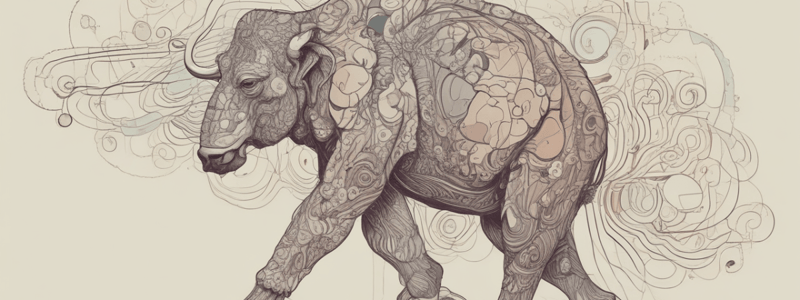Podcast
Questions and Answers
What type of information does the 'study room' in the analogy represent?
What type of information does the 'study room' in the analogy represent?
- Production rules and modules in ACT-R Cognitive Architecture
- Implicit Memory, including skills and habits
- Explicit Memory, including semantic statements and episodic events (correct)
- Language acquisition and Universal Grammar
Which cognitive architecture operates serially, processing one production rule at a time?
Which cognitive architecture operates serially, processing one production rule at a time?
- ACT-R Cognitive Architecture (correct)
- Chomsky's Universal Grammar
- Fodor's Language of Thought
- Simplified Mnemonic Explicit Memory
What is the primary focus of Fodor's Model of mental language?
What is the primary focus of Fodor's Model of mental language?
- Episodic events and semantic statements
- Innate grammatical structure for language acquisition
- Serial information processing and production rules
- Mental language 'Mentalese' for all cognitive processes (correct)
What do 'Procedural Patterns' in Implicit Memory refer to?
What do 'Procedural Patterns' in Implicit Memory refer to?
Which concept explains the innate grammatical structure for language acquisition?
Which concept explains the innate grammatical structure for language acquisition?
What is the primary difference between Fodor's theory and Chomsky's theory?
What is the primary difference between Fodor's theory and Chomsky's theory?
What type of imagery involves internal representations of sensory experiences from any sense?
What type of imagery involves internal representations of sensory experiences from any sense?
What is the primary function of the sympathetic nervous system?
What is the primary function of the sympathetic nervous system?
What is the primary difference between the dorsal stream and the ventral stream?
What is the primary difference between the dorsal stream and the ventral stream?
What is the term for the subjective experience of consciousness that is difficult to explain?
What is the term for the subjective experience of consciousness that is difficult to explain?
What is the name of the structure responsible for explicit memories?
What is the name of the structure responsible for explicit memories?
What is the primary function of the parasympathetic nervous system?
What is the primary function of the parasympathetic nervous system?
What is the term for the process of recognizing what objects are, rather than their spatial location?
What is the term for the process of recognizing what objects are, rather than their spatial location?
What is the mnemonic device used to remember the dorsal stream and ventral stream?
What is the mnemonic device used to remember the dorsal stream and ventral stream?
What type of brain wave is associated with active, focused alertness and problem-solving?
What type of brain wave is associated with active, focused alertness and problem-solving?
Flashcards are hidden until you start studying
Study Notes
Simplified Mnemonic for Memory
- Explicit Memory: "E-E-S-S" (Encyclopedia, Episodic Events, Semantic Statements)
- Implicit Memory: "I-I-P-P" (Implicit Instincts, Procedural Patterns, Priming Precepts)
ACT-R Cognitive Architecture
- Operates serially, processing one production rule at a time
- Consists of multiple specialized modules interacting with a central production system
- Models human cognitive processing with a focus on serial and step-by-step information processing
Fodor's Language of Thought vs. Chomsky's Universal Grammar
- Fodor's Model: focuses on mental language 'Mentalese' used for all cognitive processes
- Chomsky's Universal Grammar: explains the innate grammatical structure for language acquisition
- Both models emphasize innateness but differ in application; Fodor's is broad, Chomsky's is language-specific
Mental Imagery vs. Visual Imagery
- Mental Imagery: involves internal representations of sensory experiences from any sense
- Visual Imagery: specifically involves internal visualizations, like 'seeing' images in the mind
HARD PROBLEM OF CONSCIOUSNESS
- Involves subjective experience, e.g. "Left Laughter, Right Rain"
Brain Waves
- Gamma: high mental activity and information integration, ideal for gamers
- Beta: active, focused alertness, characteristic of cognitive tasks and problem-solving
- Alpha: calm, relaxed yet awake state, always ready but calm
- Delta: slow and high-amplitude waves seen in deep, restorative sleep and unconscious states
Autonomic Nervous System
- Sympathetic: prepares body for rapid action in stressful situations, "speed"
- Parasympathetic: helps body to relax, conserve energy after stress, "pause"
Limbic System and Broca Aphasia
- Limbic: associated with love
- Broca aphasia: difficulty with language production, "buy bread store"
Dorsal and Ventral Streams
- "SPACE FACE" mnemonic: Spatial, Parietal, Above path, Cortex connection, Ending, Form, Anterior path, Cortex connection, Ending with Extra
- Dorsal Stream: deals with spatial location, begins at striate cortex, ends at Posterior Parietal Cortex
- Ventral Stream: focuses on form recognition, begins at striate cortex, ends at Inferior Temporal Cortex
Hippocampus
- plays a role in forming explicit memories
Studying That Suits You
Use AI to generate personalized quizzes and flashcards to suit your learning preferences.




